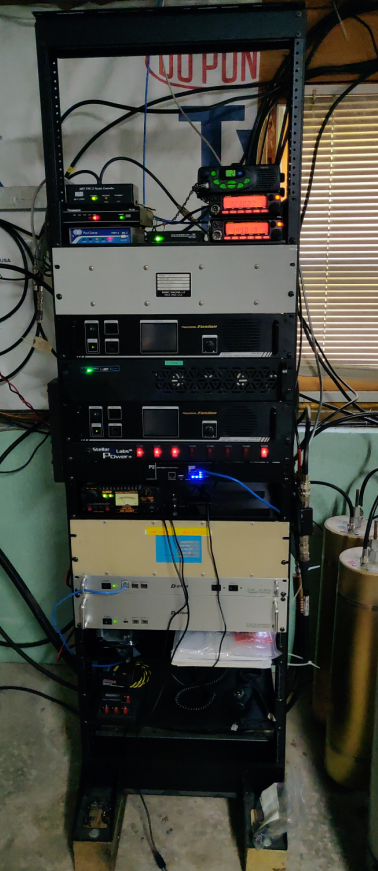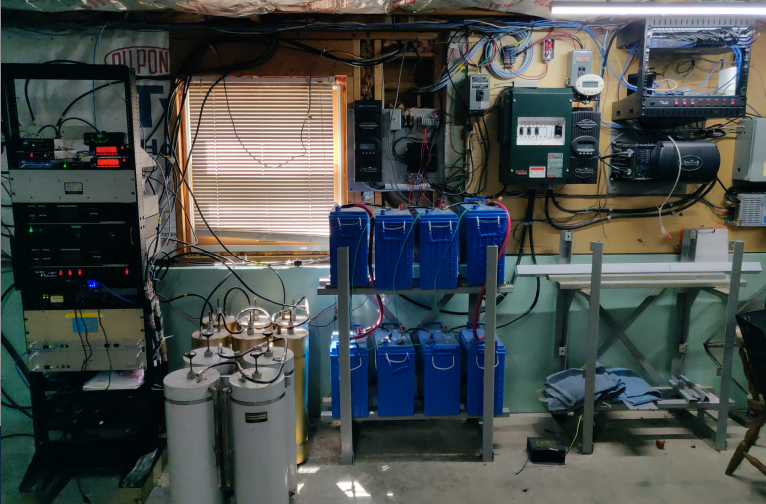Repeaters
MARA Repeaters
Phippsburg, Maine, FN53ct
147.210 MHz (pl 100 Hz) FM & C4FM
444.400 MHz (pl 88.5 Hz) FM & C4FM (WIRES-X)
447.575 MHz D-Star
145.010 MHz KS1R-1 Packet Node, Alias = BURG
Gardner, Maine, FN54ce
444.400 MHz (pl 114.8 Hz) FM & C4FM (WIRES-X)
Radio gear
The top shelf contains three TNCs and radios that are part of a ax.25 packet system. TNCs: MFJ TNC-X, Timewave PK-96, PacComm Tiny-2 MK-2. Radios: Alinco DR-135 MKII, DR-235 MKII, Tait TM8115.
Then we have some 440 duplexers, a Yeasu System Fusion DR-2X repeater, the WOPR (computer running all this stuff), another Yeasu DR-2X, switched receptacles, Pakedge P2 Ethernet controlled receptacles, shelf holding a Alinco DM-330MV power supply, more 440 duplexers, Icom ID-RP2C D-Star repeater Controller, Icom ID-RP4000V UHF digital voice repeater.
To the right of the rack sits two sets of VHF duplexers.
The WOPR computer, a 19” 2U computer in the radio rack that runs this stuff has an ASROCK ITX-3455 main board. This is a low power setup, using less then 25W. Moving around voice packets and being a local NAS just doesn’t need much power. The WOPR runs OpenSuse Leap and hosts 4 virtual machines. Lubuntu for the packet node, CentOS for the D-Star gateway, pi-hole for local add blocking, and a Windows 7 VM for the Yeasu fusion stuff. WTH Yeasu? No Linux support? Really? (Not a Yeasu fan)
Supporting Equipment
Solar Electric
The heart of the solar electric system is the Outback Power Systems inverter on the right under the wall mount 19” equipment rack. Its a 3700W continuous, 7200W for 15s utility interactive inverter. To its left is a DC breaker box and one of the two Mate MX charge controllers. The other charge controller is just to the right of the window. Hard to miss are 8 blue Fullriver DC335-6 batteries in the battery rack. Not in the picture is the 2.2KW solar array.
The system chooses solar power first, utility power second, and batteries as a last resort. This is because the grid is a very efficient system for storing energy. A lot more efficient then batteries. On top of that if the batteries were cycled regularly they would need to be replaced more often.
This system was installed in 2005. I have had no issues of mention with the exception of having to replace the batteries twice so far.
Ethernet Equipment
In the 19” equipment rack on the wall has a POE switch, cable modem, pfsense router with 2X LANs. One for the radio network, one for local stuff. The WOPR (mentioned above) has an add on PCIE 4 port LAN card. This allows it to participate in the radio LAN, local LAN, dedicated port for the D-Star controller, and one port bridged into the radio LAN for the Ethernet switched receptacles.

